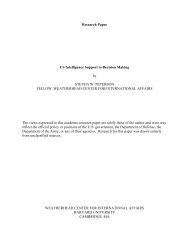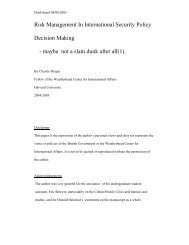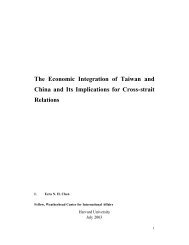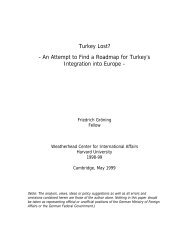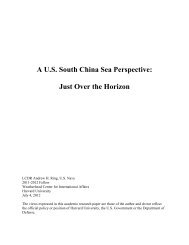A U.S. South China Sea Perspective: Just Over the Horizon
A U.S. South China Sea Perspective: Just Over the Horizon
A U.S. South China Sea Perspective: Just Over the Horizon
Create successful ePaper yourself
Turn your PDF publications into a flip-book with our unique Google optimized e-Paper software.
During <strong>the</strong> protracted Cold War, tensions between <strong>the</strong> U.S. and Soviet navies resulted in<br />
skirmishes where ships held standoffs and engaged in provocative exercises, submarines<br />
sideswiped each o<strong>the</strong>r or collided, shots were fired, mock attacks were held, and in a few cases,<br />
sailors were killed — situations that could have escalated into all-out war. Fortunately <strong>the</strong> worst<br />
that occurred amounted to just “international incidents”. However, in 1972 <strong>the</strong> United States and<br />
Soviet Union signed <strong>the</strong> U.S.-Soviet Incidents at <strong>Sea</strong> Agreement that provided steps for each<br />
navy to follow so that <strong>the</strong>ir respective operations would not interfere with <strong>the</strong> o<strong>the</strong>r and prevent<br />
scenarios that could quickly escalate. 75 Provisions such as requiring surveillance ships to<br />
maintain safe distances, informing vessels when submarines exercise near <strong>the</strong>m, and requiring<br />
aircraft commanders to use caution when approaching o<strong>the</strong>r aircraft, helped prevent <strong>the</strong> Cold<br />
War turning hot. The same provisions may have prevented <strong>the</strong> EP-3 collision, <strong>the</strong> harassment of<br />
ocean surveillance ships and <strong>the</strong> “inadvertent encounter” of a Chinese submarine colliding with<br />
<strong>the</strong> towed sonar array of <strong>the</strong> U.S. destroyer as described earlier. The United States attempted to<br />
sign a formal Incident at <strong>Sea</strong> agreement with <strong>China</strong> in 2009 but <strong>China</strong> refused. 76 Vietnam<br />
succeeded in reaching a similar agreement with <strong>China</strong> last year. Before increasing U.S. presence<br />
in <strong>the</strong> <strong>South</strong> <strong>China</strong> <strong>Sea</strong>, <strong>the</strong> United States must convince <strong>the</strong> Chinese of <strong>the</strong> strategic need for an<br />
Incident at <strong>Sea</strong> agreement or else history will continue to repeat itself. Increased U.S. naval<br />
presence in <strong>the</strong> <strong>South</strong> <strong>China</strong> <strong>Sea</strong> will not likely resolve <strong>the</strong> <strong>South</strong> <strong>China</strong> <strong>Sea</strong> disputes and could<br />
complicate <strong>the</strong> diplomatic situation fur<strong>the</strong>r for ASEAN. Hosting U.S. naval vessels will only<br />
complicate <strong>the</strong> political bargaining position of a country when conducting bilateral negotiations<br />
with <strong>China</strong> or, by extension, in multilateral discussions between ASEAN and <strong>China</strong>.<br />
The U.S. goals that have been set for <strong>the</strong> <strong>South</strong> <strong>China</strong> <strong>Sea</strong> include: maintaining freedom<br />
of navigation, ensuring <strong>the</strong> free flow of trade vessels and peacefully resolving <strong>the</strong> maritime<br />
46



